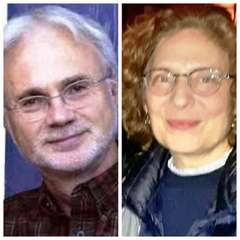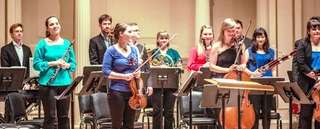|
Back
Two Worlds in One Concert New York
Weill Concert Hall, Carnegie Hall
02/19/2019 -
Colin McPhee: Balinese Ceremonial Music
Steve Reich: Quartet
Julia Wolfe: On Seven-Star Shoes
John Adams: Chamber Symphony
Ensemble Connect (Members and Alumni): Leo Sussman (Flute), Tamara Winston (Oboe), Noémi Sallai, Bixby Kennedy (Clarinets), Yen Chen Wu (Bassoon), Rémy Taghavi (Contrabassoon), Thea Humphries (Horn), Brian Olson (Trumpet), Oliver Barrett (Trombone), Gergana Haralampieva (Violin), Meagan Turner (Viola), Arlen Hlusko (Cello), Ha Young Jung (Bass), Tomer Gewirtzman, Christopher Goodpasture (Pianos), Sae Hashimoto, Brandon Ilaw (Percussion), Jesse Brault (Guest Conductor)

J. Adams/J. Wolfe (© Samuel T. Dog)
Deductive and inductive. Platonic and Dionysian. East and West. Stasis and volition.
The two halves of the concert last night by Ensemble Connect were diametrically opposed in style, in feeling. Yes, they complemented each other thoroughly, and were executed faultlessly by these young artists. Even more important, one had, at the end, a new feeling toward 20th Century American-created music in general.
I had never heard of Ensemble Connect before, but (according to the program notes), it is a “two-year fellowship program for extraordinary young professional classical musician residing in the US that prepares them for careers...” Much like Michael Tilson Thomas’ orchestral forays in Florida.
And extraordinary is the word. For not a single one of the four works was anything but challenging, technically improbable. Yet–unlike its dodecaphonic cousins in Europe–these four composers were looking for color, for effect. The methods were mathematical, the results were emotional.
The first half might have been called “energy in stasis.” Colin McPhee not only lived in Bali for several years during the 1930’s (writing a splendid book about his life), but transcribed much of the music, culminating in this two-piano Ceremonial Balinese Music.
Any transcribed score shows that the gamelan takes a single rhythmical theme and induces the notes over and over and over again in different patterns. Debussy was the first to love it, though others have wondered at how it works.
In Bali, I have had the questionable pleasure of sitting through six hours of the drumming and gongs, and rarely bored. Here, two excellent pianists, Tomer Gewirtzman and Christopher Goodpasture, kept their feet on the pedals, hit the notes with repetitive percussive strokes and gave a terrific replica of small and large gongs and a whole contingent of non-percussive percussion. The illusion of surging forward without actually going anywhere was caught by Mr. McPhee, and the two pianists projected that illusion with digital legerdemain.
They returned to another Asian-influenced work with two vibraphonists, Sae Hashimoto and Brandon Ilaw, for Steve Reich’s Quartet. The composer considers this “one of the most complex” he had ever written. That may be overstating it, yet the virtuosity and pitch-perfect ensemble coordination is fascinating. As with Mr. McPhee’s work, one rarely sees the work progressing in any structural way. Perhaps Mr. Reich had a complex behind the three movements, but one was far more transfixed on the sounds themselves, and the nuanced movements of the two percussionists.

Some of Ensemble Connect (© Tomas Bazika)
These two works were the apotheoses of sound itself. With the second half, we heard movement, volatility. The sounds were incandescent, yet in a way they were tools (okay, instruments) which led us to a series of Western-style climaxes.
Julia Wolfe was in the audience to hear her very earliest work, On Seven-Star Shoes, a chamber-orchestra version from the Expressionistic poetry of German-Jewish poet Else Lasker-Schüler. It must have been an exciting premiere for Ms. Wolfe, for this was a punchy woodwind quintet. The energy was pure early Stravinsky, but the confidence and vigor was that of a young composer who obviously was unafraid.
The longest and largest and most familiar work was John Adams’ modestly titled Chamber Symphony. And the entire Ensemble Connect, conducted by Jesse Brault, banged on their cans, tootled on their brass, strummed on their strings (with a magnificent solo cadenza by Bulgarian violinist Gergana Haralampieva) and made a great and frequently noise unto the heavens. (Or at least unto the Baroque decor of Weill Hall.)
This was the first time I had heard Chamber Symphony live. Some music is fine on record. This needs vibration and surprise. And Mr. Adams achieved such gorgeousness in chaos, such form in anarchy and–dare I say it?–such a classical harmony in the last measures with the brass playing in thirds–that one would love to re-title it “Chamber Hosanna.”
Harry Rolnick
|